Papers by Maha Abdeladhim
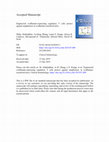
Clinical Immunology, Oct 1, 2019
Allergy is a major public health concern, the main treatment for which is symptomatic relief with... more Allergy is a major public health concern, the main treatment for which is symptomatic relief with antiinflammatory drugs. A key clinical challenge is to induce specific tolerance in order to control allergen-specific memory B and T cells, and specifically block effector cell responses. Our lab recently developed antigenspecific regulatory T-cell (Treg) therapies as a treatment for adverse responses. Recently, we created a chimeric antigen receptor (CAR) approach in which we engineered a target protein antigen, ovalbumin (OVA), linked with the transmembrane and signal transduction domains, CD28-CD3ζ to directly target B cells and sensitized mast cells in an allergy model. We named this receptor "BAR" for B-cell Antibody Receptor. Murine or human Tregs, transduced with a BAR containing OVA or control Tregs expressing an unrelated antigen, were successfully expanded in vitro and tested in the murine OVA-alum allergy model with measurable titers of anti-OVA IgE. Because BAR Tregs express the target antigen and could interact with specific IgE on sensitized mast cells, we first demonstrated that intravenously injected OVA-BAR Tregs did not directly lead to a drop in temperature or release of mediators in plasma indicative of anaphylaxis. Forty-eight hours later, mice were challenged intraperitoneally with 200µg OVA to induce an anaphylactic reaction, and temperature immediately measured for 30 minutes. We found that OVA-BAR Tregs protected mice from hypothermia, whereas mice given control BARs (expressing an unrelated antigen) or PBS showed substantial temperature drops indicative of anaphylaxis when systemically challenged with OVA. Importantly, this effect was also demonstrated in a passive anaphylaxis model in which mice that received anti-OVA IgE antibody were protected from hypothermia when treated with OVA-BAR Tregs prior to systemic OVA challenge. These results provide proof of principle that engineered allergen-specific T-regulatory cells can provide clinical protection against severe allergic reactions in individuals already IgE-sensitized to an allergen.
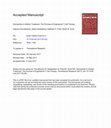
Translational Research, Sep 1, 2017
Hemophilia A is a bleeding disorder caused by mutations in the gene encoding factor VIII (FVIII),... more Hemophilia A is a bleeding disorder caused by mutations in the gene encoding factor VIII (FVIII), a cofactor protein that is essential for normal blood clotting. Approximately one in three patients with severe hemophilia A produce neutralizing antibodies (inhibitors) that block its biologic function in the clotting cascade. Current efforts to eliminate inhibitors consist of repeated FVIII injections under what is termed an "ITI" protocol (Immune Tolerance Induction). However, this method is extremely costly and approximately 30% of patients undergoing ITI do not achieve peripheral tolerance. Human T regulatory cells (Tregs) have been proposed as a new strategy to treat this anti-drug antibody response, as well as other diseases. Polyclonal Tregs are nonspecific and could potentially cause general immunosuppression. Novel approaches to induce tolerance to FVIII include the use of engineered human and mouse antigen-specific Tregs, or alternatively antigen-specific cytotoxic cells, to delete, anergize or kill FVIII-specific lymphocytes. In this review, we discuss the current state of engineered T-cell therapies, and we describe recent progress in applying these therapies to induce FVIII-specific tolerance.
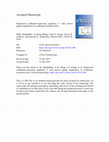
Journal of Immunology, May 1, 2018
Allergy is a major public health concern, the main treatment for which is symptomatic relief with... more Allergy is a major public health concern, the main treatment for which is symptomatic relief with antiinflammatory drugs. A key clinical challenge is to induce specific tolerance in order to control allergen-specific memory B and T cells, and specifically block effector cell responses. Our lab recently developed antigenspecific regulatory T-cell (Treg) therapies as a treatment for adverse responses. Recently, we created a chimeric antigen receptor (CAR) approach in which we engineered a target protein antigen, ovalbumin (OVA), linked with the transmembrane and signal transduction domains, CD28-CD3ζ to directly target B cells and sensitized mast cells in an allergy model. We named this receptor "BAR" for B-cell Antibody Receptor. Murine or human Tregs, transduced with a BAR containing OVA or control Tregs expressing an unrelated antigen, were successfully expanded in vitro and tested in the murine OVA-alum allergy model with measurable titers of anti-OVA IgE. Because BAR Tregs express the target antigen and could interact with specific IgE on sensitized mast cells, we first demonstrated that intravenously injected OVA-BAR Tregs did not directly lead to a drop in temperature or release of mediators in plasma indicative of anaphylaxis. Forty-eight hours later, mice were challenged intraperitoneally with 200µg OVA to induce an anaphylactic reaction, and temperature immediately measured for 30 minutes. We found that OVA-BAR Tregs protected mice from hypothermia, whereas mice given control BARs (expressing an unrelated antigen) or PBS showed substantial temperature drops indicative of anaphylaxis when systemically challenged with OVA. Importantly, this effect was also demonstrated in a passive anaphylaxis model in which mice that received anti-OVA IgE antibody were protected from hypothermia when treated with OVA-BAR Tregs prior to systemic OVA challenge. These results provide proof of principle that engineered allergen-specific T-regulatory cells can provide clinical protection against severe allergic reactions in individuals already IgE-sensitized to an allergen.
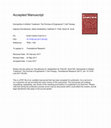
Translational research : the journal of laboratory and clinical medicine, Sep 9, 2017
Hemophilia A is a bleeding disorder caused by mutations in the gene encoding factor VIII (FVIII),... more Hemophilia A is a bleeding disorder caused by mutations in the gene encoding factor VIII (FVIII), a cofactor protein that is essential for normal blood clotting. Approximately, 1 in 3 patients with severe hemophilia A produce neutralizing antibodies (inhibitors) that block its biologic function in the clotting cascade. Current efforts to eliminate inhibitors consist of repeated FVIII injections under what is termed an "ITI" protocol (Immune Tolerance Induction). However, this method is extremely costly and approximately 30% of patients undergoing ITI do not achieve peripheral tolerance. Human T regulatory cells (Tregs) have been proposed as a new strategy to treat this antidrug antibody response, as well as other diseases. Polyclonal Tregs are nonspecific and could potentially cause general immunosuppression. Novel approaches to induce tolerance to FVIII include the use of engineered human and mouse antigen-specific Tregs, or alternatively antigen-specific cytotoxic cells,...

Blood
Traditional methods for chimeric antigen receptor (CAR) T manufacturing utilize viral vectors, ex... more Traditional methods for chimeric antigen receptor (CAR) T manufacturing utilize viral vectors, ex vivo activation and expansion of T cells to achieve clinically relevant cell numbers, which leads to an exhausted T cell phenotype, high manufacturing costs, and treatment delays. The UltraCAR-T platform is designed to overcome these limitations using our advanced non-viral gene delivery system and a rapid, overnight manufacturing process (Blood 2019 134 (Supplement_1):2660; Blood 2020 136 (Supplement 1):17); Cancer Research 2020 80 (16Suppl):6593). UltraCAR-T cells, which express antigen specific CAR, membrane-bound IL-15 (mbIL15), and kill switch genes, are manufactured at the medical center's cGMP facility using autologous T cells and administered back to the patient only one day after gene transfer. UltraCAR-T cells are currently under clinical investigation for hematological (NCT03927261) and solid tumors (NCT03907527). Here we describe the advancement of the UltraCAR-T platfor...
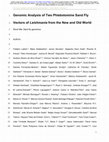
Phlebotomine sand flies are of global significance as important vectors of human disease, transmi... more Phlebotomine sand flies are of global significance as important vectors of human disease, transmitting bacterial, viral, and protozoan pathogens, including the devastating kinetoplastid parasites of the genus Leishmania, the causative agents of diseases collectively termed leishmaniasis. More than 40 pathogenic Leishmania species are transmitted to humans by approximately 35 sand fly species in 98 countries with hundreds of millions of people at risk around the world. As no approved efficacious vaccine exists, available drugs are expensive and/or toxic, and resistance is emerging, management of sand fly populations to break transmission is currently the most effective disease control strategy. To better understand the biology of sand flies, including the mechanisms involved in their vectorial capacity, insecticide resistance, and population structures we sequenced the genomes of two of the most important sand fly species: Phlebotomus papatasi, a cutaneous leishmaniasis vector, (dist...

Frontiers in Cellular and Infection Microbiology, 2022
Sand flies are hematophagous insects responsible for the transmission of vector-borne diseases to... more Sand flies are hematophagous insects responsible for the transmission of vector-borne diseases to humans. Prominent among these diseases is Leishmaniasis that affects the skin and mucous surfaces and organs such as liver and spleen. Importantly, the function of blood-sucking arthropods goes beyond merely transporting pathogens. The saliva of vectors of disease contains pharmacologically active components that facilitate blood feeding and often pathogen establishment. Transcriptomic and proteomic studies have enumerated the repertoire of sand fly salivary proteins and their potential use for the control of Leishmaniasis, either as biomarkers of vector exposure or as anti-Leishmania vaccines. However, a group of specific sand fly salivary proteins triggers formation of cross-reactive antibodies that bind the ectodomain of human desmoglein 1, a member of the epidermal desmosomal cadherins. These cross-reactive antibodies are associated with skin autoimmune blistering diseases, such as ...
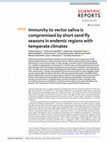
Scientific Reports, 2020
Individuals exposed to sand fly bites develop humoral and cellular immune responses to sand fly s... more Individuals exposed to sand fly bites develop humoral and cellular immune responses to sand fly salivary proteins. Moreover, cellular immunity to saliva or distinct salivary proteins protects against leishmaniasis in various animal models. In Tbilisi, Georgia, an endemic area for visceral leishmaniasis (VL), sand flies are abundant for a short period of ≤3 months. Here, we demonstrate that humans and dogs residing in Tbilisi have little immunological memory to saliva of P. kandelakii, the principal vector of VL. Only 30% of humans and 50% of dogs displayed a weak antibody response to saliva after the end of the sand fly season. Likewise, their peripheral blood mononuclear cells mounted a negligible cellular immune response after stimulation with saliva. RNA seq analysis of wild-caught P. kandelakii salivary glands established the presence of a typical salivary repertoire that included proteins commonly found in other sand fly species such as the yellow, SP15 and apyrase protein fami...
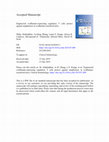
Clinical Immunology, 2019
Allergy is a major public health concern, the main treatment for which is symptomatic relief with... more Allergy is a major public health concern, the main treatment for which is symptomatic relief with antiinflammatory drugs. A key clinical challenge is to induce specific tolerance in order to control allergen-specific memory B and T cells, and specifically block effector cell responses. Our lab recently developed antigenspecific regulatory T-cell (Treg) therapies as a treatment for adverse responses. Recently, we created a chimeric antigen receptor (CAR) approach in which we engineered a target protein antigen, ovalbumin (OVA), linked with the transmembrane and signal transduction domains, CD28-CD3ζ to directly target B cells and sensitized mast cells in an allergy model. We named this receptor "BAR" for B-cell Antibody Receptor. Murine or human Tregs, transduced with a BAR containing OVA or control Tregs expressing an unrelated antigen, were successfully expanded in vitro and tested in the murine OVA-alum allergy model with measurable titers of anti-OVA IgE. Because BAR Tregs express the target antigen and could interact with specific IgE on sensitized mast cells, we first demonstrated that intravenously injected OVA-BAR Tregs did not directly lead to a drop in temperature or release of mediators in plasma indicative of anaphylaxis. Forty-eight hours later, mice were challenged intraperitoneally with 200µg OVA to induce an anaphylactic reaction, and temperature immediately measured for 30 minutes. We found that OVA-BAR Tregs protected mice from hypothermia, whereas mice given control BARs (expressing an unrelated antigen) or PBS showed substantial temperature drops indicative of anaphylaxis when systemically challenged with OVA. Importantly, this effect was also demonstrated in a passive anaphylaxis model in which mice that received anti-OVA IgE antibody were protected from hypothermia when treated with OVA-BAR Tregs prior to systemic OVA challenge. These results provide proof of principle that engineered allergen-specific T-regulatory cells can provide clinical protection against severe allergic reactions in individuals already IgE-sensitized to an allergen.
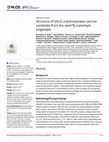
PLoS neglected tropical diseases, 2017
Immunity to the sand fly salivary protein SALO (Salivary Anticomplement of Lutzomyia longipalpis)... more Immunity to the sand fly salivary protein SALO (Salivary Anticomplement of Lutzomyia longipalpis) protected hamsters against Leishmania infantum and L. braziliensis infection and, more recently, a vaccine combination of a genetically modified Leishmania with SALO conferred strong protection against L. donovani infection. Because of the importance of SALO as a potential component of a leishmaniasis vaccine, a plan to produce this recombinant protein for future scale manufacturing as well as knowledge of its structural characteristics are needed to move SALO forward for the clinical path. Recombinant SALO was expressed as a soluble secreted protein using Pichia pastoris, rSALO(P), with yields of 1g/L and >99% purity as assessed by SEC-MALS and SDS-PAGE. Unlike its native counterpart, rSALO(P) does not inhibit the classical pathway of complement; however, antibodies to rSALO(P) inhibit the anti-complement activity of sand fly salivary gland homogenate. Immunization with rSALO(P) pro...
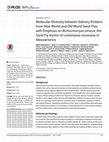
PLOS Neglected Tropical Diseases, 2016
Background Sand fly saliva has been shown to have proteins with potent biological activities, sal... more Background Sand fly saliva has been shown to have proteins with potent biological activities, salivary proteins that can be used as biomarkers of vector exposure, and salivary proteins that are candidate vaccines against different forms of leishmaniasis. Sand fly salivary gland transcriptomic approach has contributed significantly to the identification and characterization of many of these salivary proteins from important Leishmania vectors; however, sand fly vectors in some regions of the world are still neglected, as Bichromomyia olmeca (formerly known as Lutzomyia olmeca olmeca), a proven vector of Leishmania mexicana in Mexico and Central America. Despite the importance of this vector in transmitting Leishmania parasite in Mesoamerica there is no information on the repertoire of B. olmeca salivary proteins and their relationship to salivary proteins from other sand fly species. Methods and Findings A cDNA library of the salivary glands of wild-caught B. olmeca was constructed, sequenced, and analyzed. We identified transcripts encoding for novel salivary proteins from this sand fly species and performed a comparative analysis between B. olmeca salivary proteins and those from other sand fly species. With this new information we present an updated catalog of the salivary proteins specific to New World sand flies and salivary proteins common to all
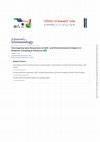
Journal of immunology (Baltimore, Md. : 1950), Jan 29, 2016
The etiology of human autoimmune diseases in general remains largely unknown, although the geneti... more The etiology of human autoimmune diseases in general remains largely unknown, although the genetic and environmental interplay may be relevant. This applies to the autoimmune diseases of the skin such as the pemphigus phenotypes and others. In this group, there is an endemic form of pemphigus foliaceus (also known as fogo selvagem [FS]) in which the pathogenic IgG4 autoantibody response to the self-antigen desmoglein 1 (Dsg1) cross-reacts with the LJM11 sand fly salivary gland Ag. In this investigation, we dissected the IgG4 autoantibody repertoires used by FS patients in response to endogenous self-Dsg1 and exogenous LJM11 sand fly Ag. Based on analyses of the genetic clonal signatures of these Abs, our results indicate that there is a significant overlap between these two responses, as all identified IgG4 mAbs cross-react to both Dsg1 and LJM11 Ags. Germline H- and L-chain V gene Abs generated according to mutated cross-reactive mAbs preserved their reactivity to both Ags. Our fin...
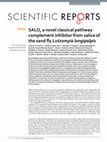
Scientific Reports, 2016
Blood-feeding insects inject potent salivary components including complement inhibitors into thei... more Blood-feeding insects inject potent salivary components including complement inhibitors into their host’s skin to acquire a blood meal. Sand fly saliva was shown to inhibit the classical pathway of complement; however, the molecular identity of the inhibitor remains unknown. Here, we identified SALO as the classical pathway complement inhibitor. SALO, an 11 kDa protein, has no homology to proteins of any other organism apart from New World sand flies. rSALO anti-complement activity has the same chromatographic properties as the Lu. longipalpis salivary gland homogenate (SGH)counterparts and anti-rSALO antibodies blocked the classical pathway complement activity of rSALO and SGH. Both rSALO and SGH inhibited C4b deposition and cleavage of C4. rSALO, however, did not inhibit the protease activity of C1s nor the enzymatic activity of factor Xa, uPA, thrombin, kallikrein, trypsin and plasmin. Importantly, rSALO did not inhibit the alternative or the lectin pathway of complement. In conc...
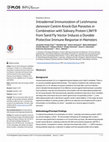
PLOS Neglected Tropical Diseases, 2016
Background Visceral leishmaniasis (VL) is a neglected tropical disease and is fatal if untreated.... more Background Visceral leishmaniasis (VL) is a neglected tropical disease and is fatal if untreated. There is no vaccine available against leishmaniasis. The majority of patients with cutaneous leishmaniasis (CL) or VL develop a long-term protective immunity after cure from infection, which indicates that development of an effective vaccine against leishmaniasis is possible. Such protection may also be achieved by immunization with live attenuated parasites that do not cause disease. We have previously reported a protective response in mice, hamsters and dogs with Leishmania donovani centrin gene knockout parasites (LdCen-/-), a live attenuated parasite with a cell division specific centrin1 gene deletion. In this study we have explored the effects of salivary protein LJM19 as an adjuvant and intradermal (ID) route of immunization on the efficacy of LdCen-/parasites as a vaccine against virulent L. donovani. Methodology/Principal Findings To explore the potential of a combination of LdCen-/parasites and salivary protein LJM19 as vaccine antigens, LdCen-/-ID immunization followed by ID challenge with virulent L. donovani were performed in hamsters in a 9-month follow up study. We determined parasite burden (serial dilution), antibody production (ELISA) and cytokine expression (qPCR) in these animals. Compared to controls, animals immunized with LdCen-/-+ LJM19 induced a strong antibody response, a reduction in spleen and liver parasite burden and a higher
PLoS neglected tropical diseases, 2015
There is an error in the third sentence of the "Detection of human anti-PpSP32 antibodies" subsec... more There is an error in the third sentence of the "Detection of human anti-PpSP32 antibodies" subsection of the Methods section. The concentration of PpSP32 should read 2 ug/ml = 0.2 ug/well, not 2 mg/ml = 0.1 mg/well.
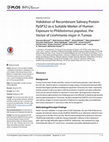
PLoS neglected tropical diseases, 2015
During a blood meal, female sand flies, vectors of Leishmania parasites, inject saliva into the h... more During a blood meal, female sand flies, vectors of Leishmania parasites, inject saliva into the host skin. Sand fly saliva is composed of a large variety of components that exert different pharmacological activities facilitating the acquisition of blood by the insect. Importantly, proteins present in saliva are able to elicit the production of specific anti-saliva antibodies, which can be used as markers for exposure to vector bites. Serological tests using total sand fly salivary gland extracts are challenging due to the difficulty of obtaining reproducible salivary gland preparations. Previously, we demonstrated that PpSP32 is the immunodominant salivary antigen in humans exposed to Phlebotomus papatasi bites and established that humans exposed to P. perniciosus bites do not recognize it. Herein, we have validated, in a large cohort of 522 individuals, the use of the Phlebotomus papatasi recombinant salivary protein PpSP32 (rPpSP32) as an alternative method for testing exposure to...
International Journal of Dermatology, 2015
References 1 Wo zniak K, Kazama T, Kowalewski C. A practical technique for differentiation of sub... more References 1 Wo zniak K, Kazama T, Kowalewski C. A practical technique for differentiation of subepidermal bullous diseases: localization of in vivo-bound IgG by laser scanning confocal microscopy. Arch Dermatol 2003; 139: 1007–1011. 2 Wolff K, Rappersberger K, Steiner A, et al. Vegetating cicatricial pemphigoid. A new subset of the cicatricial pemphigoid spectrum. Arch Dermatol Res 1987; 279 (Suppl.): S30–S37. 3 Wo zniak K, G orkiewicz A, Olszewska M, et al. Cicatricial pemphigoid vegetans. Int J Dermatol 2007; 46: 299–302.
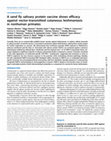
Science translational medicine, Jan 3, 2015
Currently, there are no commercially available human vaccines against leishmaniasis. In rodents, ... more Currently, there are no commercially available human vaccines against leishmaniasis. In rodents, cellular immunity to salivary proteins of sand fly vectors is associated to protection against leishmaniasis, making them worthy targets for further exploration as vaccines. We demonstrate that nonhuman primates (NHP) exposed to Phlebotomus duboscqi uninfected sand fly bites or immunized with salivary protein PdSP15 are protected against cutaneous leishmaniasis initiated by infected bites. Uninfected sand fly-exposed and 7 of 10 PdSP15-immunized rhesus macaques displayed a significant reduction in disease and parasite burden compared to controls. Protection correlated to the early appearance of Leishmania-specific CD4(+)IFN-γ(+) lymphocytes, suggesting that immunity to saliva or PdSP15 augments the host immune response to the parasites while maintaining minimal pathology. Notably, the 30% unprotected PdSP15-immunized NHP developed neither immunity to PdSP15 nor an accelerated Leishmania-...

Uploads
Papers by Maha Abdeladhim